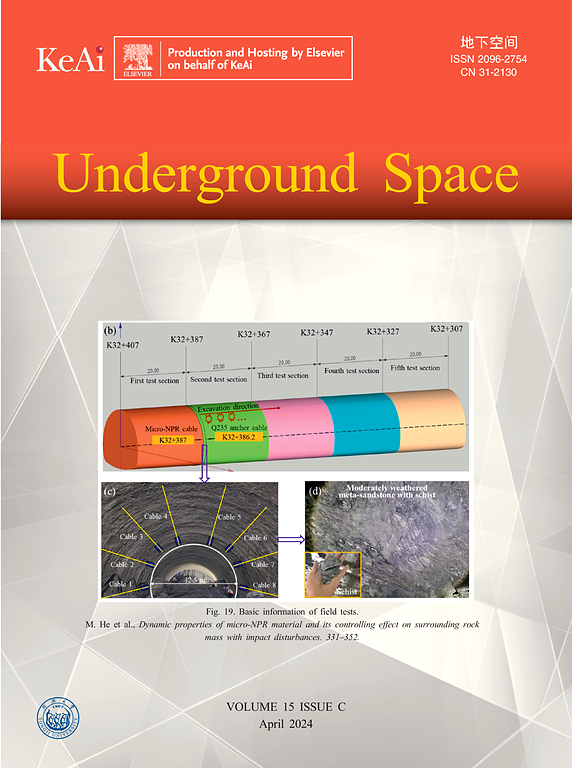Model test on the effects of shield machine cutterhead vibration on tunnel face stability in sandy ground
IF 8.3
1区 工程技术
Q1 ENGINEERING, CIVIL
引用次数: 0
Abstract
Face stability is one of the essential problems in shield tunneling. When tunneling in cobble stratum or mixed face ground conditions, significant cutting-induced cutterhead vibration would occur and affect the face stability. To reveal the mechanism and effect of vibration on the tunnel face stability, a transparent tunnel model with a movable vibration exciter was designed and a series of model tests were performed under different vibration magnitudes Aa and frequencies f. Meanwhile, particle image velocimetry was used to reveal the displacement field and the failure pattern of the tunnel face. The test results indicate that the cutting-induced vibration produces a significant reduction effect on the tunnel face stability, as expressed by the increase of the face support pressure and the failure zone when the vibration magnitude and frequency increase. Compared with the static unloading conditions, the width of the failure wedge Lwt increased by about 5.75% and 35.66% for the loose and dense sand, respectively, under dynamic unloading conditions (Aa = 0.2g, f = 10 Hz). The limit support pressure increased up to about 0.20γD at a vibration of 0.3g and 50 Hz, much larger than those of static conditions, which were about 0.08γD–0.09γD. An observable self-stabilizing arch can be formed in dense sand under static unloading conditions, while under dynamic unloading conditions, the long-time stable soil arch would not occur. The contributions of this paper could provide an insightful understanding of the effects of cutterhead vibration on tunnel face stability.
砂质地层中盾构机刀盘振动对隧道工作面稳定性影响的模型试验
工作面稳定性是盾构施工的关键问题之一。在砾石地层或混合工作面地层条件下掘进时,会产生明显的切割诱发刀盘振动,影响工作面稳定性。为了揭示振动对巷道工作面稳定性的影响机理和作用机理,设计了带有可动激振器的透明隧道模型,并在不同振动量级Aa和频率f下进行了一系列模型试验,同时利用粒子成像测速技术揭示了巷道工作面位移场和破坏形态。试验结果表明,切割振动对巷道工作面稳定性有显著的降低作用,表现为随着振动幅度和频率的增加,工作面支护压力和破坏区域增大。动态卸载条件(Aa = 0.2g, f = 10 Hz)下,与静态卸载条件相比,松散砂和致密砂的破坏楔宽度Lwt分别增大了约5.75%和35.66%。在0.3g、50 Hz振动条件下,极限支撑压力增大至0.20γD左右,远高于静态条件下的0.08γ d ~ 0.09γ d左右。在静卸载条件下,密实砂土中可形成明显的自稳定拱,而在动卸载条件下,不会形成长期稳定的土拱。本文的研究成果有助于深入理解刀盘振动对巷道工作面稳定性的影响。
本文章由计算机程序翻译,如有差异,请以英文原文为准。
求助全文
约1分钟内获得全文
求助全文
来源期刊

Underground Space
ENGINEERING, CIVIL-
CiteScore
10.20
自引率
14.10%
发文量
71
审稿时长
63 days
期刊介绍:
Underground Space is an open access international journal without article processing charges (APC) committed to serving as a scientific forum for researchers and practitioners in the field of underground engineering. The journal welcomes manuscripts that deal with original theories, methods, technologies, and important applications throughout the life-cycle of underground projects, including planning, design, operation and maintenance, disaster prevention, and demolition. The journal is particularly interested in manuscripts related to the latest development of smart underground engineering from the perspectives of resilience, resources saving, environmental friendliness, humanity, and artificial intelligence. The manuscripts are expected to have significant innovation and potential impact in the field of underground engineering, and should have clear association with or application in underground projects.
 求助内容:
求助内容: 应助结果提醒方式:
应助结果提醒方式:


